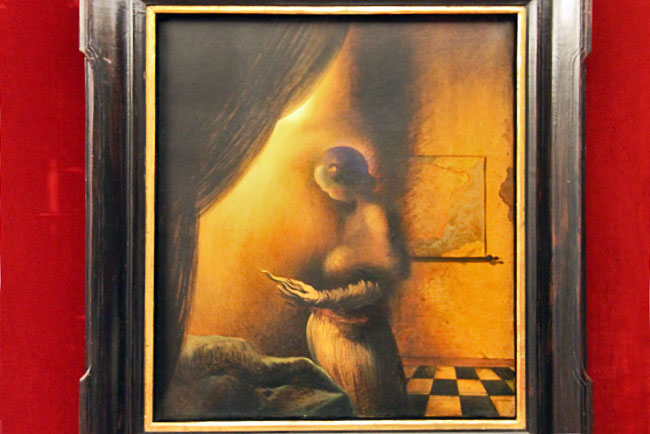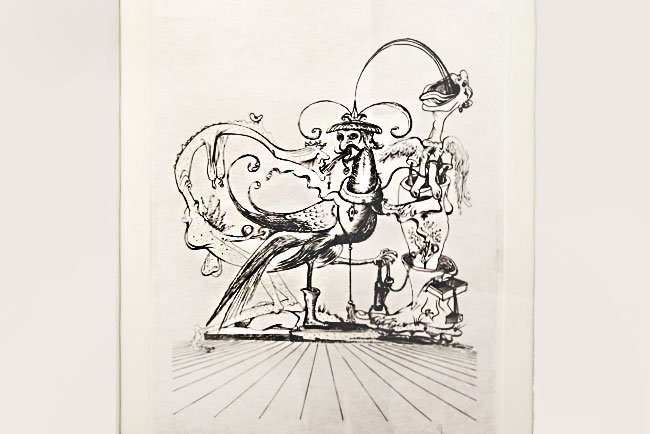I must have been 11 or 12 years old when my art teacher showed us a photo of one The Persistence of Memory, one of the best known works of Salvador Dali. I didn’t quite know what to make of its melting stopwatches and the walrus-like rotting head but I knew the disturbing images were a riddle waiting to be unraveled. I was a sucker for a mystery; no one could possibly have read more Nancy Drew novels than I had. Just like that, I was hooked.
For many years I knew only about the artist’s surrealist and cubist works, but when I moved to Florida briefly in 2006 I visited the Dalí Museum in St. Petersburg. This largest collection of Dali works outside of Spain includes a series of floor-to-ceiling canvases that contain optical illusions or double images that can be interpreted in different ways. I wrote about this technique in an earlier story that illustrated this technique in Dali’s painting, Halucinogenic Toreador (view it here). Some of the phantom images, such as Venus de Milo morphing into a bullfighter, are immediately apparent, however many of the illusions are harder to see. Look closely and you can pick out a dying bull with a pool of blood becoming a lagoon and a Dalmation dog, among others.

Salvador Dali called this his “paranoic-critical method,” with which he exploited the mind’s ability to perceive links between things which are not rationally linked. Humans do this constantly. We see images in cloud formations or a sinister hulking figure in the shadow cast by a pile of trash in a dark alley. Dali carried this to extreme, stimulating paranoia in order to destabilize his world and document the results in his art.
He did not have far to go to enter a paranoid state. From early childhood, the young Dali suffered abuse that incapacitated him emotionally for his entire life. He was named after his older brother, Salvador, who died nine months before Dali was born. His parents suffered great guilt over the death of the first Salvador and kept a lace-draped portrait of the deceased child in their bedroom. When Dali was old enough to understand, they took him to his brother’s grave site and explained that he was the reincarnation of his older sibling. Subsequently, Dali found it difficult to sleep and could only do so if he imagined himself lying in a coffin, dying. Yet even though Dali’s mother insisted he was the older brother incarnate, she dressed him as a girl in the early years because she had wanted this child to be female.
Can’t view the above slideshow of the Dali Theatre-Museum in Figueres, Spain? Click here.
As an adolescent, Dali continued to dress quite effeminately and was considered a ‘dandy’ by his peers. Several of Dali’s schoolmates, and later his fellow artists, were certain that he was a homosexual; one or two even made unsuccessful advances. Throughout his life the artist denied any homosexual leanings, yet he was quite insistent that the androgynous human form was the most beautiful and he much preferred working with male models. At the age of 25 Dali met his lifelong muse, Gala, with whom he lived until her death in 1982. The couple reputedly had sex only once during their 53 years together, as Dali had a deep-seated terror of venereal disease, which he insisted was the result of reading a book on the subject that his father had left out on the piano when he was a child. Gala, on the other hand, had many affairs, with Dali’s blessing, as he preferred watching rather than participating. Though Dali may have been able to control his simmering demons in everyday affairs, after my visit to the Dali Teatro-Muesem in Figueres, Spain I understood that they emerged time and again in his art.

The museum displays scores of the artist’s pen and ink drawings of fantasy creatures that barely resemble humans. Almost all contain bizarre phallic scenes, such as the above, which shows an emaciated hermaphrodite penetrating a half-man, half-bird creature, who then spews semen back into the mouth of the hermaphrodite and a third, winged creature with severed and bleeding arms. A great deal of his work deals with the subject of masturbation, which was certainly Dali’s primary means of sexual pleasure throughout his life. His works on the subject may have been an attempt to expunge guilt in an era when the church preached that masturbation caused blindness, impotence, and homosexuality.
Can’t view the above slide show of the Salvador and Gala Dali villa in Portlligat, Spain? Click here.
Many experts are of the opinion that the works of Salvador Dali are auto-biographical. After viewing the collection in the Figueres Museum, which was built and filled by Dali as a permanent monument to himself, I have to agree. Clearly, he was an egotist with an inferiority complex, which drove him to excessive exhibitionism, and not only with his art. Gala and Dali’s home in Portlligat, Spain, now open to the public, was extravagantly and luxuriously furnished. His publicity seeking antics for the press included delivering a lecture wearing a deep-sea diving suit and insisting that he and Gala attend a masquerade ball in New York City dressed as the Lindbergh baby and his kidnapper. Most photos of Dali, especially in his latter years, show him posing for the camera with the the bulging eyes of a madman, leaving me to wonder whether he had truly lost his mind or was just playing a part.

I’m never really sure if I like or dislike his work. But one thing you can say is that it does draw and hold your attention.
That’s for sure, Roberto!
While I am not really an art buff, I do enjoy Dali. Great post.
Thanks Julio. As you can probably tell, I’m fascinated by the mind of the man who came up with the artwork Dali created.
Fascinating man and artist. I think the more modern art grows on you over time. The woman and old man are almost Escher like in their “hidden” qualities.
I’m absolutely fascinated by his work that has “hidden” objects, Mark, but this time I learned a whole lot more about the man/child.
Great post! Really liked the extra insight about Dali.
Thanks Talon – glad you enjoyed it. The more I learn about Dali, the more he fascinates me.
I’d love to go to Dali’s villa – fascinating to understand how the artist’s childhood experiences influenced his art
And the more I learn, the more fascinated I become, Heather!